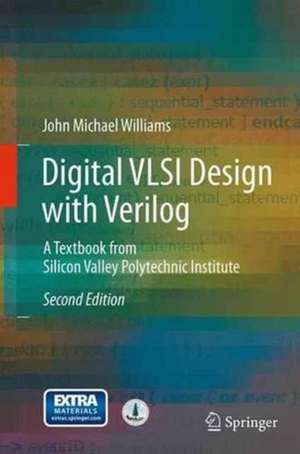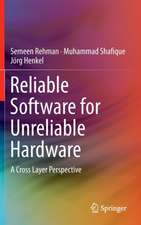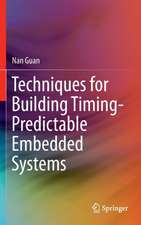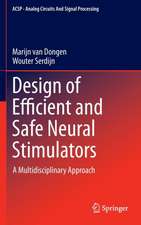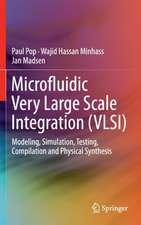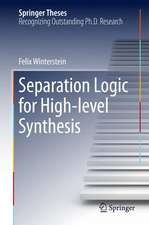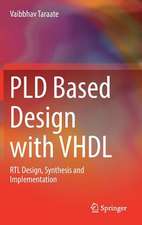Digital VLSI Design with Verilog: A Textbook from Silicon Valley Polytechnic Institute
Autor John Michael Williamsen Limba Engleză Paperback – 24 sep 2016
| Toate formatele și edițiile | Preț | Express |
|---|---|---|
| Paperback (1) | 648.30 lei 38-44 zile | |
| Springer International Publishing – 24 sep 2016 | 648.30 lei 38-44 zile | |
| Hardback (1) | 1012.85 lei 43-57 zile | |
| Springer International Publishing – 8 iul 2014 | 1012.85 lei 43-57 zile |
Preț: 648.30 lei
Preț vechi: 841.95 lei
-23% Nou
Puncte Express: 972
Preț estimativ în valută:
124.05€ • 129.87$ • 102.64£
124.05€ • 129.87$ • 102.64£
Carte tipărită la comandă
Livrare economică 02-08 aprilie
Preluare comenzi: 021 569.72.76
Specificații
ISBN-13: 9783319330983
ISBN-10: 3319330985
Pagini: 569
Ilustrații: XVI, 553 p. 273 illus., 116 illus. in color.
Dimensiuni: 155 x 235 mm
Ediția:Softcover reprint of the original 2nd ed. 2014
Editura: Springer International Publishing
Colecția Springer
Locul publicării:Cham, Switzerland
ISBN-10: 3319330985
Pagini: 569
Ilustrații: XVI, 553 p. 273 illus., 116 illus. in color.
Dimensiuni: 155 x 235 mm
Ediția:Softcover reprint of the original 2nd ed. 2014
Editura: Springer International Publishing
Colecția Springer
Locul publicării:Cham, Switzerland
Cuprins
Introductory Material.- Week 1 Class 1.- Week 1 Class 2.- Week 2 Class 1.- Week 2 Class 2.- Week 3 Class 1.- Week 3 Class 2.- Week 4 Class 1.- Week 4 Class 2.- Week 5 Class 1.- Week 5 Class 2.- Week 6 Class 1.- Week 6 Class 2.- Week 7 Class 1.- Week 7 Class 2.- Week 8 Class 1.- Week 8 Class 2.- Week 9 Class 1.- Week 9 Class 2.- Week 10 Class 1.- Week 10 Class 2.- Week 11 Class 1.- Week 11 Class 2.- Week 12 Class 1.- Week 12 Class 2.
Recenzii
“As the title states, this is a textbook for a graduate course on digital design. … the text is mostly oriented to the professor, providing a perfect tool to drive the course. The text is well structured by weeks and class sessions … needed to cover most of the aspects involved in an introductory digital design course. … I am sure that students using this book will learn enough to start working in any Silicon company.” (Javier Castillo, Computing Reviews, March, 2015)
Notă biografică
After spending some years at sea in the U. S. Navy, John Michael Williams returned to school for degrees at Columbia University, the University of Chicago and Southern Illinois University, eventually studying human vision in postdoctoral study at the University of Michigan. He moved to California in 1982 and spent significant work time as an applications engineer at Daisy Systems and then at Compass Design Automation. After attending various physics-related classes at Stanford, he began teaching at Silicon Valley Technical Institute, where he wrote the first edition of "Digital VLSI Design with Verilog" and many other course workbooks which now are posted at Scribd. He moved to Oregon a few years ago, where he remains mostly retired.
Textul de pe ultima copertă
This book is structured as a step-by-step course of study along the lines of a VLSI integrated circuit design project. The entire Verilog language is presented, from the basics to everything necessary for synthesis of an entire 70,000 transistor, full-duplex serializer-deserializer, including synthesizable PLLs. The author includes everything an engineer needs for in-depth understanding of the Verilog language: Syntax, synthesis semantics, simulation, and test. Complete solutions for the 27 labs are provided in the downloadable files that accompany the book. For readers with access to appropriate electronic design tools, all solutions can be developed, simulated, and synthesized as described in the book. A partial list of design topics includes design partitioning, hierarchy decomposition, safe coding styles, back annotation, wrapper modules, concurrency, race conditions, assertion-based verification, clock synchronization, and design for test. A concluding presentation of special topics includes SystemVerilog and Verilog-AMS.
- Covers the entire Verilog language – using most of it in practice;
- Provides 27 lab exercises, with complete and tested answers;
- Explains and emphasizes synthesizability, wherever it pertains to language features;
- Develops as a major project a synthesizable 70,000-gate SerDes;
- Presents synthesis-relevant usage of SystemVerilog, and the basic functionality of Verilog-AMS.
Caracteristici
Covers the entire Verilog language – using most of it in practice Provides 27 lab exercises, with complete and tested answers Explains and emphasizes synthesizability, wherever it pertains to language features Develops as a major project a synthesizable 70,000-gate Ser Des Presents synthesis-relevant usage of System Verilog and the basic functionality of Verilog-AMS Includes supplementary material: sn.pub/extras
